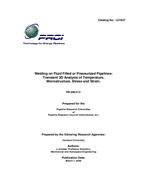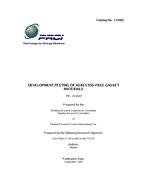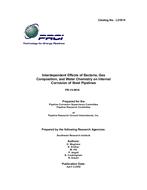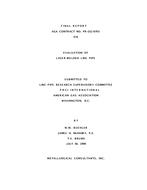Provide PDF Format
PRCI PR-206-013
- Welding on Fluid Filled Pressurized Pipelines: Transient 3D Analysis of Temperature, Microstructure, Stress, and Strain
- Report / Survey by Pipeline Research Council International, 03/01/2000
- Publisher: PRCI
$125.00$249.00
L51647e
Carleton University
(e-book version) Need: There is an incentive to weld on a pressurized pipeline both for the attachment of branch connections (hot taps) and in repair situations such as direct deposition of weld metal or welded sleeves. Welding pipelines under pressure can avoid the costs incurred by shutting down the pipeline. In thinner walled pipes, there is a risk of burn-through when welding while the pipeline is pressurized.
Benefit: The objective of this project was to determine if research in Computational Weld Mechanics had matured to the stage where it could simulate the process of welding on a pressurized pipeline and provide useful estimates of the risk of burn-through. To achieve that objective we have compared the results of our FEM analyzes of several welds with the experimental data reported in "http://www.prci.com/publications/L51763.htm" PR-185-9515, Repair of Pipelines by Direct Deposition of Weld Metal: Further Studies. The temperature and deformation predicted by our FEM analysis agrees quite well with the experimental data. The critical input data in addition to the internal pressure in the pipe, the geometry of the pipe, the size and shape of the weld pool including weld reinforcement, are the convection coefficient on the internal pipe surface and the temperature dependence of the viscosity of the pipe metal. Our FEM analysis shows that creep under the weld pool can thin the pipe wall and form a groove. In welds that show significant groove formation and thus high risk of burn through, this groove is significantly deeper than in welds that are at low risk of burn-through. When the pipe wall is thinned by the groove, the internal pipe wall temperature increases under the weld pool. Also the groove could reduce the convection on the internal pipe wall. This would further increase the temperature on the internal pipe wall under the weld pool and further accelerate actual burn-through. In our FEM analysis, we found no significant groove formation in those welds for which no significant groove formation was reported in the PR-185-9515 experiments. We found significant groove formation exactly in those welds that burned-through or were at high risk of burn-through. In those welds, the FEM analyses predicted a somewhat deeper groove than experiment. This suggests the FEM analyses erred on the safe side. In this sense, we conclude that we have succeeded in computing useful estimates of the risk of burn-through using Computational Weld Mechanics. It is notable that almost no use is made of adjustable or tuning parameters. To simulate the actual burn-through we conjecture that we would need to include inertial forces in the stress analysis.
Result: This document concludes that useful estimates of the risk of burn-through in the process of welding on pressurized thin-walled steel pipes can be computed using the FEM methodologies described in this report.
Carleton University
(e-book version) Need: There is an incentive to weld on a pressurized pipeline both for the attachment of branch connections (hot taps) and in repair situations such as direct deposition of weld metal or welded sleeves. Welding pipelines under pressure can avoid the costs incurred by shutting down the pipeline. In thinner walled pipes, there is a risk of burn-through when welding while the pipeline is pressurized.
Benefit: The objective of this project was to determine if research in Computational Weld Mechanics had matured to the stage where it could simulate the process of welding on a pressurized pipeline and provide useful estimates of the risk of burn-through. To achieve that objective we have compared the results of our FEM analyzes of several welds with the experimental data reported in "http://www.prci.com/publications/L51763.htm" PR-185-9515, Repair of Pipelines by Direct Deposition of Weld Metal: Further Studies. The temperature and deformation predicted by our FEM analysis agrees quite well with the experimental data. The critical input data in addition to the internal pressure in the pipe, the geometry of the pipe, the size and shape of the weld pool including weld reinforcement, are the convection coefficient on the internal pipe surface and the temperature dependence of the viscosity of the pipe metal. Our FEM analysis shows that creep under the weld pool can thin the pipe wall and form a groove. In welds that show significant groove formation and thus high risk of burn through, this groove is significantly deeper than in welds that are at low risk of burn-through. When the pipe wall is thinned by the groove, the internal pipe wall temperature increases under the weld pool. Also the groove could reduce the convection on the internal pipe wall. This would further increase the temperature on the internal pipe wall under the weld pool and further accelerate actual burn-through. In our FEM analysis, we found no significant groove formation in those welds for which no significant groove formation was reported in the PR-185-9515 experiments. We found significant groove formation exactly in those welds that burned-through or were at high risk of burn-through. In those welds, the FEM analyses predicted a somewhat deeper groove than experiment. This suggests the FEM analyses erred on the safe side. In this sense, we conclude that we have succeeded in computing useful estimates of the risk of burn-through using Computational Weld Mechanics. It is notable that almost no use is made of adjustable or tuning parameters. To simulate the actual burn-through we conjecture that we would need to include inertial forces in the stress analysis.
Result: This document concludes that useful estimates of the risk of burn-through in the process of welding on pressurized thin-walled steel pipes can be computed using the FEM methodologies described in this report.
Related Products
PRCI PR-15-9916
Interdependent Effects of Bacteria, Gas Composition, and Water Chemistry on Internal Corrosion of St..
$348.00 $695.00
PRCI PR-015-064503
Detection of Small Leaks in Liquid Pipelines: Gap Study of Available Methods (PL-1)..
$38.00 $75.00





